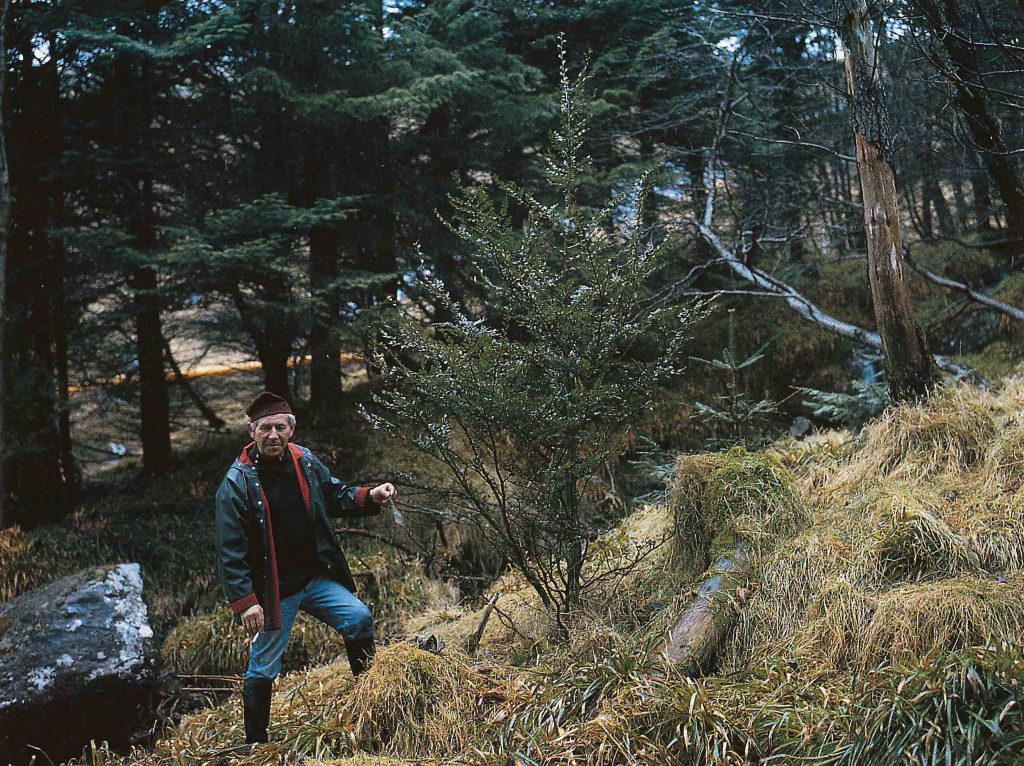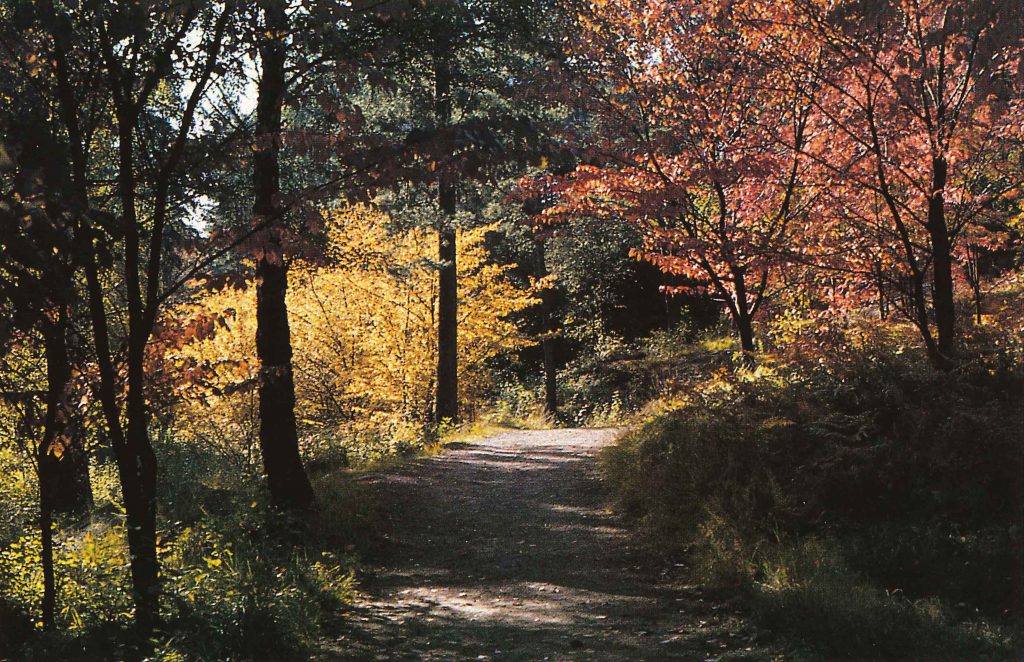
A WORD TO EXPLAIN
The word arboretum (arboreta in the plural) comes from the Latin arbor, which means tree, and the ending -etum, which can be translated as “planting place for”. In everyday speech, we mean a planted collection of trees and/or shrubs from different parts of the world.
WHAT IS AN ARBORETUM USED FOR?
To begin with, a couple of related terms should be mentioned. The first is arboriculture, which means tree cultivation. The other is silviculture, i.e. forestry. The step between them is obviously not long, seemingly mostly a matter of quantity.
However, the activities of a traditional arboretum have a fundamentally different and broader purpose than that of the silvicultural institutions, whose main goal is to produce forest trees (of a few species) for the further production of timber, paper pulp and other technical products.
The arboretum as an educational resource
An arboretum is primarily a study collection of planted native as well as foreign trees and shrubs. From the living trees in an educationally structured arboretum, we can obtain facts and information in such diverse subjects as, for example, taxonomy, plant geography, genetics, physiology, ecology and pathology.
Some examples of users are forestry and agricultural colleges, universities, horticultural schools and “regular” schools. Of course, the arboretum also has an important function in the service of general education. Increasingly attention has been paid to the arboretum’s educational role in horticulture and environmental protection.
The arboretum in the service of silviculture
When it comes to the purely practical use, it is usually said that the arboretum’s lignose (woody plants) primarily represent an important potential as purely ornamental plants or as environmental improvers in urban or other artificial environments.
However, well-documented facilities where stocks of naturally collected and selected species and provenances are grown also have significant silvicultural interest. Even the traditional arboretums have their importance for silviculture, as the cultivation of individual taxa (species, varieties, etc.) often first occurred or occurs there. In terms of quantity and utilization of the plants’ climate racial differentiation, the so-called stand arboretum, which emerged from the mid-20th century in the Nordic region, has an activity that is very close to that of the silvicultural institutions. In the extensive material in these arboretums there are species and provenances with, among other things, widely different climate tolerances. You could probably say that we have silvi and horticultural gene banks here.
Considering the alarm reports that now fairly unanimously speak of a global climate change, caused, among other things, by unrestrained emissions of carbon dioxide and other gases as well as rainforest destruction, these species and provenances may, thanks to their genetic variation, become of even greater silvicultural significance in a near future.
This anticipation, which the arboretum’s plant material can be said to represent, is of course of equal importance for future horticulture and environmental protection.
The arboretum in the service of horticulture
As one of the most important basic industries in the Nordics, forestry is “outstanding” in comparison with, for example, the horticulture industry, but the latter sector is gaining an ever greater importance in society.
The gardening industry turns over billions on the ornamental plant side alone, and in Sweden, for example, the “green sector” employs at least 25,000 people. Home gardening belongs, at least in the slightly more southern parts of the Nordic region, to our main leisure pursuits. Seen in the light of this and the fact that the majority of the decorative lignoids sold in the Nordics are imported from the continent, where the quality requirements, especially in terms of hardness, do not correspond to our needs, there is an extremely large scope for quality improvement. It is a situation that has only recently begun to be noticed.
For a few years, inventories and trials have been underway in various parts of the Nordic region in the direction of producing our own production of decorative lignoids adapted to our climate. Several of our Nordics participate in this work arboreta with, for example, trial cultivation of horticulturally promising material.
The Nordic Arboretum Committee (see below) has an important function here as a coordinator and platform for the new introduction of material from, among other things, joint collection expeditions.
The arboretum in the service of environmental protection
In addition to the purely ornamental value of lignose, selections of both domestic and foreign trees are gaining an ever greater role and use as environmental improvers in, for example, cities and industrial areas. The meaning of trees and green spaces is manifold. Their presence positively affects both the psychological and physical environment.
The most important positive effects on the physical environment include oxygen production, air particle filtration, gas absorption, wind attenuation, air humidity leveling, temperature regulation and noise attenuation.
Several of these effects are also important components for our psychological well-being. A more refined effect on the psychic environment is linked to color and shape. wealth.
A greater variety also counteracts the catastrophic consequences of variety- or species-specific diseases, such as elm disease, which in today’s monocultures spread quickly.
It can be said to be a clear common goal for the Nordic arboretums to work towards a greater selection of lignos being available on the market. As we shall see, the acquisition of new material through joint collection expeditions is also a priority area in the Nordic arboretum collaboration.
Priority areas
Shortly after the formation of the Committee, four areas were set up, within which Nordic cooperation was found to be able to produce good results and coordination gains. These were:
- Collection of new plant material through joint collection expeditions to areas of great interest to the Nordic region and which are relatively weakly represented in existing collections.
- Establishment of a common registration system and a common registration center. Inventory of plant collections (parks, private arboretums, etc.) in the Nordics and propagation of good types.
- Climatological observations and investigations in Nordic arboreta according to a jointly laid out methodology.
- Joint information activities, purchase and distribution of particularly important, but difficult to access, literature.
Collaborative model
Despite the common denominator, the institutions represented in NAU have very varied interests and resources, which is also characteristic of most Nordic cooperation groups. This means, among other things, that the collaboration must have such a character and level of ambition that the members can feel that their efforts are on a par with the exchange, which in turn, among other things, means that long-term projects, which are highly dependent on a more extensive and continuous personal commitment, can only be carried out exceptionally. The different interests are at the same time a strength. Through the recurring meetings, the participants can take part in knowledge that lies outside their normal field of activity.
The collective expertise of the members is significant and covers areas such as forest genetics, forest tree breeding, practical forestry, horticulture and systematic and ecological botany.
This brings us to the Committee’s perhaps most important function, namely to act as a platform for direct personal contacts between colleagues.
The exchange of both practical and theoretical knowledge is not only stimulating and developing for the individual members, but also benefits their parent institutions.
An important forum here is, as mentioned, the annual meetings, which travel between the countries. The annual meeting is often combined with excursions and study visits, whereby the participants have good opportunities to gain additional valuable experience of, for example, the impact of the changing Nordic climate on both cultivated and wild lignoses.

FUTURE COLLABORATIONS
There is no doubt that the experiences so far of Nordic cooperation between institutions with arboretum-related activities encourage continued and expanded cooperation. The results achieved so far what regarding knowledge exchange, plant procurement and plant exchange have already been touched upon.
One area where coordination and cooperation should be able to produce equally positive results is the registration and inventory of collections. Adequate registration of plant collections is very important for the type of activity an arboretum carries out. Generally speaking, record keeping in Nordic arboreta is a neglected area.
The importance of coordination and the need for a standardization of register types increases in step with the ever-increasing degree of internationalization. It can therefore be assumed that the business gets a more advanced position during the 9() century. Two factors that further speak for this are the constantly improved and increasingly user-friendly data registration methodology and the initiatives taken in the 80s by the Nordic Genebank and Samnordisk Planteforädling to bring about the inventory and registration of valuable horticultural lignostic material in the Nordic region.
A coordination of the activities of the groups working in the ornamental lignose sector, of which the Nordic Arboretum Committee is thus one, seems necessary and will become the model of the 90s.

